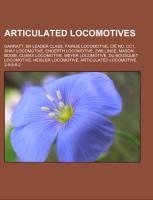
-
 Anglický jazyk
Anglický jazyk
Articulated locomotives
Autor: Source: Wikipedia
Source: Wikipedia. Pages: 28. Chapters: Garratt, SR Leader class, Fairlie locomotive, CIÉ No. CC1, Shay locomotive, Engerth locomotive, Zwillinge, Mason Bogie, Climax locomotive, Meyer locomotive, Du Bousquet locomotive, Heisler locomotive, Articulated locomotive,... Viac o knihe
Na objednávku
14.70 €
O knihe
Source: Wikipedia. Pages: 28. Chapters: Garratt, SR Leader class, Fairlie locomotive, CIÉ No. CC1, Shay locomotive, Engerth locomotive, Zwillinge, Mason Bogie, Climax locomotive, Meyer locomotive, Du Bousquet locomotive, Heisler locomotive, Articulated locomotive, 2-8-8-8-2, Golwé locomotive, Klein-Linder, Goelsdorf locomotive. Excerpt: Diagram of a Garratt locomotive Heavy SAR Garratt class GMAM at Oudtshoorn loco depot, South Africa, 1979A Garratt (also known as Beyer-Garratt) is a type of steam locomotive that is articulated in three parts. Its boiler is mounted on the centre frame, and two steam engines are mounted on separate frames, one on each end of the boiler. Articulation permits larger locomotives to negotiate curves and lighter rails that might restrict large rigid-framed locomotives. Many Garratt designs aimed to double the power of the largest conventional locomotives operating on their railways, thus reducing the need for multiple locomotives and crews. South African Railways gauge SAR NGG 16 Class Garratt, preserved in operating condition on the Welsh Highland Railway A builder's photo of K1, the first Garratt locomotiveThe Garratt articulated locomotive was developed by Herbert William Garratt, a British locomotive engineer who, after a career with British colonial railways, was the New South Wales Railways' Inspecting Engineer in London. He first applied for a patent on the idea in 1907, after observing articulated gun carriages. Garratt first approached Kitson & Co., but his idea was rejected, perhaps because that company were already committed to the Kitson-Meyer. He then approached Beyer, Peacock and Company, who were only marginally more interested. In 1907 Beyer, Peacock & Co. submitted a proposal for a gauge 0-4-0+0-4-0 Garratt to the New South Wales Government Railways, which was not proceeded with. The following year a design for a gauge Mallet locomotive was submitted in reply to an enquiry from the Government of Tasmania. This was followed with a submission for a Garratt based on, but a little heavier than, the New South Wales proposal. This proposal was accepted, and two locomotives were built in 1909, which became the K class. The K class had to cope with 99' radius curves and 1 in 25 gradients. Unlike in Garratt's patent, Tasmanian Railways insisted on a compound arr
- Vydavateľstvo: Books LLC, Reference Series
- Rok vydania: 2012
- Formát: Paperback
- Rozmer: 246 x 189 mm
- Jazyk: Anglický jazyk
- ISBN: 9781157361558


 Nemecký jazyk
Nemecký jazyk 








